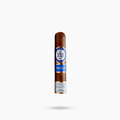The Ritual of Cigar Tasting
Tasting a cigar is not merely a sensory experience, it's a ritual. One that invites contemplation, discernment, and a profound appreciation for the craftsmanship behind each leaf. To taste a cigar like a connoisseur is to understand its story, region, and artistry.
This guide explores how to refine your palate, interpret flavour notes, and enjoy cigars with greater confidence and sophistication.
1. Pre-Light Inspection: First Impressions Matter
Before lighting, engage with the cigar's visual and tactile elements:
-
Look: Examine the wrapper’s colour, texture, and oils. A smooth, evenly coloured wrapper often suggests careful fermentation and rolling.
-
Touch: Gently squeeze to check consistency and firmness.
-
Smell: The foot of the cigar reveals pre-light aroma. Expect notes of earth, cocoa, hay, or even floral tones depending on the blend.
Pro Tip: Try comparing two different cigars side by side to understand how pre-light aromas differ by origin and wrapper type.
2. The Cut and the Cold Draw
Use a precision cutter for a clean cut, ideally just above the shoulder.
Before lighting, take a “cold draw”, a few draws without flame. This previews the cigar’s core flavours.
-
Cold Draw Notes: You may detect dried fruit, baking spices, cocoa, or grassy undertones.
-
Draw Resistance: A good cigar should offer a gentle but firm pull.
3. Lighting and First Third: Setting the Tone
Light your cigar using a butane torch or cedar spill for a clean burn.
Once lit:
-
Inhale slowly and allow the smoke to roll over your palate.
-
Avoid inhaling into your lungs, cigar smoking is about tasting, not intake.
First Third Profile:
-
This sets the tone. Look for initial flavours: pepper, earth, wood, or citrus.
-
Retrohale occasionally (exhale through the nose) to enhance your perception of aroma.
4. The Second Third: Complexity Unfolds
This is where the cigar’s body and complexity evolve. You may notice:
-
The spice softens.
-
New flavours appear: leather, nuts, espresso, dried fruit, creaminess.
-
Smoke texture thickens.
Pay Attention To:
-
Balance (no one flavour dominating)
-
Consistency (burn and flavour uniformity)
Note: Some premium cigars showcase transitions in flavour like chapters in a story. Keep mental notes or use a tasting journal.
5. The Final Third: Strength and Finish
In the final third, cigars tend to gain strength and intensity. The flavours become richer, sometimes darker.
-
Common Notes: Charred wood, dark chocolate, roasted coffee, molasses.
-
Finish: This is the lingering aftertaste. A well-constructed cigar offers a clean, satisfying finish, not harshness.
Rotate the cigar as you smoke to maintain even combustion. Tap ash gently rather than flicking.
6. Understanding the Cigar Taste Wheel
Professional tasters often refer to a cigar flavour wheel, broken into families:
-
Base: Earth, wood, leather, hay
-
Spice: Pepper, cinnamon, nutmeg
-
Sweet: Cocoa, caramel, dried fruit
-
Nutty: Almond, walnut, cashew
-
Floral & Herbal: Chamomile, grass, mint
-
Exotic: Whiskey barrel, char, stone fruit
Final Thoughts
Tasting cigars is both an art and a skill, refined over time. Whether you’re a newcomer exploring mild blends or an aficionado dissecting a full-bodied Lancero, understanding cigar taste adds immeasurable richness to the experience.
Slow down. Notice the nuances. Let the cigar speak.
Continue Your Journey
-
Discover our Beginner Cigar Bundle, a trio ideal for palate training
-
Learn the Cigar Etiquette every modern smoker should know
-
Explore Expert Storage Tips to protect flavour integrity











Comments (0)
There are no comments for this article. Be the first one to leave a message!